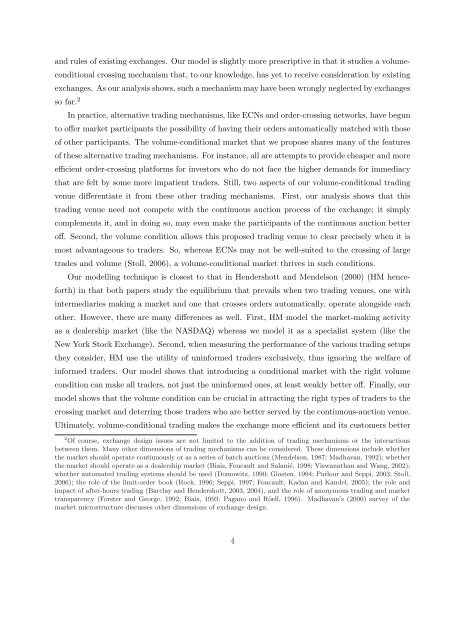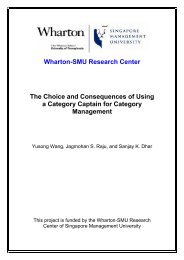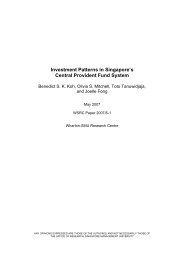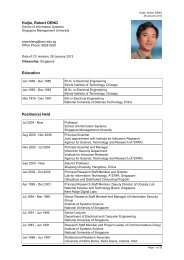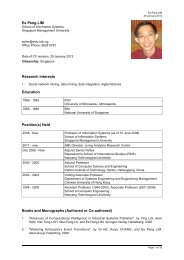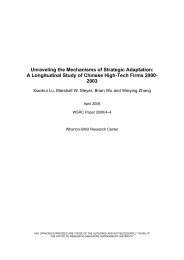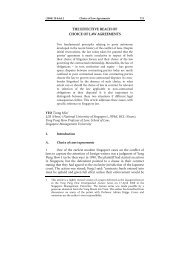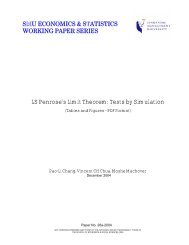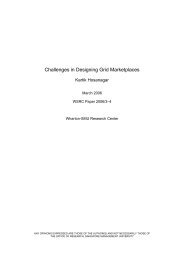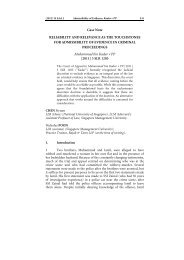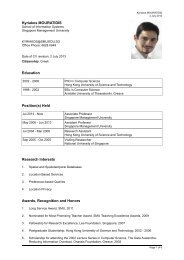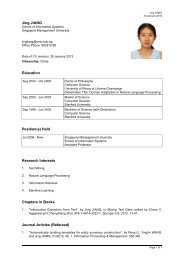The Benefits of Volume-Conditional Order-Crossing - Singapore ...
The Benefits of Volume-Conditional Order-Crossing - Singapore ...
The Benefits of Volume-Conditional Order-Crossing - Singapore ...
Create successful ePaper yourself
Turn your PDF publications into a flip-book with our unique Google optimized e-Paper software.
and rules <strong>of</strong> existing exchanges. Our model is slightly more prescriptive in that it studies a volume-<br />
conditional crossing mechanism that, to our knowledge, has yet to receive consideration by existing<br />
exchanges. As our analysis shows, such a mechanism may have been wrongly neglected by exchanges<br />
so far. 2<br />
In practice, alternative trading mechanisms, like ECNs and order-crossing networks, have begun<br />
to <strong>of</strong>fer market participants the possibility <strong>of</strong> having their orders automatically matched with those<br />
<strong>of</strong> other participants. <strong>The</strong> volume-conditional market that we propose shares many <strong>of</strong> the features<br />
<strong>of</strong> these alternative trading mechanisms. For instance, all are attempts to provide cheaper and more<br />
efficient order-crossing platforms for investors who do not face the higher demands for immediacy<br />
that are felt by some more impatient traders. Still, two aspects <strong>of</strong> our volume-conditional trading<br />
venue differentiate it from these other trading mechanisms. First, our analysis shows that this<br />
trading venue need not compete with the continuous auction process <strong>of</strong> the exchange; it simply<br />
complements it, and in doing so, may even make the participants <strong>of</strong> the continuous auction better<br />
<strong>of</strong>f. Second, the volume condition allows this proposed trading venue to clear precisely when it is<br />
most advantageous to traders. So, whereas ECNs may not be well-suited to the crossing <strong>of</strong> large<br />
trades and volume (Stoll, 2006), a volume-conditional market thrives in such conditions.<br />
Our modelling technique is closest to that in Hendershott and Mendelson (2000) (HM hence-<br />
forth) in that both papers study the equilibrium that prevails when two trading venues, one with<br />
intermediaries making a market and one that crosses orders automatically, operate alongside each<br />
other. However, there are many differences as well. First, HM model the market-making activity<br />
as a dealership market (like the NASDAQ) whereas we model it as a specialist system (like the<br />
New York Stock Exchange). Second, when measuring the performance <strong>of</strong> the various trading setups<br />
they consider, HM use the utility <strong>of</strong> uninformed traders exclusively, thus ignoring the welfare <strong>of</strong><br />
informed traders. Our model shows that introducing a conditional market with the right volume<br />
condition can make all traders, not just the uninformed ones, at least weakly better <strong>of</strong>f. Finally, our<br />
model shows that the volume condition can be crucial in attracting the right types <strong>of</strong> traders to the<br />
crossing market and deterring those traders who are better served by the continuous-auction venue.<br />
Ultimately, volume-conditional trading makes the exchange more efficient and its customers better<br />
2 Of course, exchange design issues are not limited to the addition <strong>of</strong> trading mechanisms or the interactions<br />
between them. Many other dimensions <strong>of</strong> trading mechanisms can be considered. <strong>The</strong>se dimensions include whether<br />
the market should operate continuously or as a series <strong>of</strong> batch auctions (Mendelson, 1987; Madhavan, 1992); whether<br />
the market should operate as a dealership market (Biais, Foucault and Salanié, 1998; Viswanathan and Wang, 2002);<br />
whether automated trading systems should be used (Domowitz, 1990; Glosten, 1994; Parlour and Seppi, 2003; Stoll,<br />
2006); the role <strong>of</strong> the limit-order book (Rock, 1996; Seppi, 1997; Foucault, Kadan and Kandel, 2005); the role and<br />
impact <strong>of</strong> after-hours trading (Barclay and Hendershott, 2003, 2004), and the role <strong>of</strong> anonymous trading and market<br />
transparency (Forster and George, 1992; Biais, 1993; Pagano and Röell, 1996). Madhavan’s (2000) survey <strong>of</strong> the<br />
market microstructure discusses other dimensions <strong>of</strong> exchange design.<br />
4


